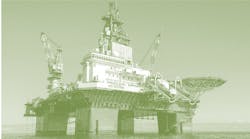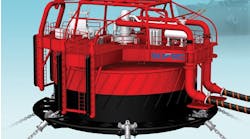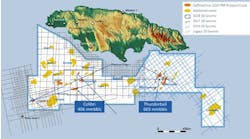Gene Kliewer - Technology Editor, Subsea & Seismic
In an effort to sustain its offshore bidding and exploration activity, Australia has contracted magnetic and seismic surveys aimed at oil and gas bidders, and makes that data available at no charge.
Geoscience Australia has acquired high-resolution magnetic data across current Commonwealth offshore Acreage Release Areas. As an example, the following is excerpts from reports on W07-12 to 15 in the offshore Canning basin, Western Australia. Similar data is available for many of the basins surrounding Australia offshore.
Magnetic data
Geoscience Australia’s commissioned aeromagnetic survey of the offshore Canning basin covered the eastern half of this survey (blocks WO7-12 and WO7-15), in-filled an existing survey with line spacing of 1,500 m (4,921 ft). The remaining area was flown at 750 m (2,461 ft) line spacing. Together with the existing data, this gave the whole area 750 m line spacing.
The survey also covers adjacent State Water Acreage Release Areas (T07-1 to 3), and ties to existing onshore and offshore magnetic survey data (Canning basin [Yampi, Pender, Broome] WA, Magnetic 1988/89 – P537).
The survey data covers an area of approximately 31,770 sq km (12,266 sq mi) and consists of a total of 56,504 line km (35,110 mi), comprising 44,633 line km (27,734 mi) of new data (flying height of 60 m [197 ft] asl) and 11,871 line km (7,376 ft) of previous data. Geoscience Australia, under a contract awarded to Fugro, provided leveled and processed data merged with pre-existing magnetic data to achieve a 750-m (2,460-ft) line spacing and 3,000 m (9,842 ft) tie line spacing grid across the release areas.
A TMI image generated from the co-processed old and new data shows the sharpest and highest amplitude field variations mostly are in the northeast and southern parts of the area. The smoothest field variations (from deeper sources) are in the northwest.
In several areas the most prominent field variations are negative anomalies (local decreases in field strength) due to predominantly remanent magnetizations of reverse polarity. A 3D display of the TMI grid shows that a large negative anomaly in the northern section of the area is the highest amplitude feature.
To simplify the magnetic field variation, and to center anomalies directly above their source bodies, a reduction to pole (RTP) transform was applied to the data. This does not correctly treat the anomalies due to remanent magnetization, but because that remanence is almost anti-parallel to the present geomagnetic field, the anomalies are not severely distorted (but retain their negative polarity).
To highlight anomalies over shallow sources, with little influence from magnetization direction, an analytic signal transform was applied.
Another data enhancement which proved useful was the tilt filter. This filter reduces the significance of the amplitude of field variations and accentuates linear trends in the data.
The vertical derivative and tilt filter enhancements of the reduced-to-pole TMI grid were used to trace the axes of linear anomalies, and terminations and displacements in the magnetic field. These linears are plotted over the first vertical derivative (FVD) and tilt filter images. There is a complex pattern of trends in the magnetic images, with north/south, northwest/southeast, and southwest/northeast trends, each consistent with known extensional and compressive events over the protracted history of the basin.
Seismic interpretation
This regional seismic data interpretation was carried out as an adjunct to the Encom Technology Pty Ltd. aeromagnetic study.
These new areas cover an area that ranges from 8 km to 190 km (5 mi to 118 mi) offshore. Water depths for the two inboard blocks range from less than 20 m (66 ft) to about 80 m (262 ft). The two outboard blocks range from 40 m (131 ft) to 300 m (984 ft) along the northwestern margin.
Data spacing in the Paleozoic dip direction varied from 10 km to 14 km (6 mi to 9 mi) in the southern blocks and 4 km to 12 km (2.5 mi to 7.5 mi) in the northern blocks. In the strike direction the spacing varied from 20 km to 30 km (12.5 mi to 18.5 mi) in the southern blocks and 5 km to 40 km (3 mi to 25 mi) in the northern ones.
Paleozoic well ties could be made to the northeastern Kambara 1 and Perindi 1 wells. Acepede 1A penetrated Jurassic sediments overlying Early Permian (Asselian) and terminated in Late Carboniferous. Wamac 1 penetrated a similar interval (DITR 2007). Mingin 1 and Pearl 1 are not on available seismic data. The base Tertiary and the base Cretaceous were also tied to East Mermaid.
Two-way time maps were constructed for the designated horizons above. Geosciences Australia provided bathymetry data as well as stacking velocities from the JN88 and LS98 seismic surveys. These velocities were converted to interval velocities using Petrosys (DIX method). Depth conversion for each horizon was based on a single interval from sea floor. When tested against well tops errors were less than 5%.
The architecture that defines these areas is one of a complex inverted and eroded graben flanked to the north by massive undeformed basement, to the south by the eroded Ordovician Platform and overlain disconformably by folded and thrusted Mesozoics.
Seven structural events have been documented in this area.
Graben fill appears to be very thick. In the inboard axial areas it appears to extend below at least 3.5 seconds or 8 to 10 km (5 to 6 mi) and early fill may be Silurian/Ordovician and or meta sediments. In deeper seismic data basement is difficult to discern. The graben flanking faults are also poorly imaged suggesting that at least in the north these faults have in part been exposed and eroded as scarps.
Evidence for both pre-Late Carboniferous extension and compression are evident in the seismic data.
Early Permian extension resulted in block faulting. In the Mid-Triassic, transpression resulted in very large scale inversion and formation of positive complex flower structures. This Triassic overprinting dominates the current architecture. Compression in the Late Miocene led to reactivation of the major faults.
Small scale Late Miocene wrench faults occur along the northern margin of the graben. These faults are limited to the immediate northern margin, are vertical and probably en echelon. They terminate in the latest Tertiary. They have the appearance of and may be associated with gas chimneys. •
Acknowledgements
Acknowledgement for the seismic part of the interpretation goes to Henk van Paridon of Geosolve Pty Ltd. for providing depth analysis of the seismic data set and producing high quality depth structure maps. Acknowledgement also to Dr. John Kennard of Geoscience Australia who provided his knowledge and ensured the timely flow of data.
Disclaimer
This seismic interpretation was performed on limited regional data and its accuracy cannot be assured. The illustrated potential play types are not intended to represent definitive leads or prospects and OEC Pty Ltd accepts no liability in any case where these data are otherwise misconstrued.
Recent lease action
The degree of interest in exploration offshore Australia can be gauged by the degree of interest in new offshore leases. In 3Q 2007, Australia awarded 11 new offshore permits out of 21 bids with the winning bid promising to spend a total of $800 million in exploration activities.
Under the work program bidding system, applicants are required to nominate a guaranteed minimum “dry hole” exploration program for each of the first three years of the permit term and a “secondary” program for the remaining three years. Each component of the program must be completed in the designated year or earlier. Permits are awarded for an initial term of six years and may be renewed twice for periods of five years.
“The high number of bids and the huge investment companies are prepared to make shows the great interest in Australian offshore petroleum exploration,” says Ian Macfarlane, Australia’s resources minister. “More than $800 million will be invested over the next six years to explore Australian oil and gas opportunities, taking total investment in the 2006 offshore petroleum acreage release to almost $2.2 billion.”
The areas are in Commonwealth waters off Western Australia, Tasmania, and the Northern Territory, and include four permits in Designated Frontier Areas (DFAs).
“Companies which take on the greater risk of exploring in DFAs are eligible for favorable tax rates because it is in these unexplored frontier areas that we expect to find major new oil or gas reserves,” Macfarlane says.
These are the new permit areas:
- Permit NT/P74 (released as NT06-3) in the northern Arafura basin went to Samson International (Australia) Pty Ltd. The company proposed a guaranteed work program of 1,400 km (870 mi) 2D seismic and geotechnical studies at an estimated cost of $2.78 million. The secondary work program consists of two exploration wells and 400 sq km (154 sq mi) 3D seismic survey at an estimated cost of $33 million. There were no other bids for this permit.
- Permit NT/P75 (released as NT06-4) in the northern Arafura basin was awarded to Samson International (Australia) Pty Ltd. The company proposed a guaranteed work program of 2,200 km (1,367 mi) 2D seismic survey and geotechnical studies at an estimated cost of $4.18 million. The secondary work program consists of two wells and 700 sq km (270 sq mi) 3D seismic survey at an estimated cost of $35 million. There were no other bids for this permit.
- Permit T/48P (released as T06-5) in the Sorell basin was awarded to Santos Offshore Pty Ltd. The company proposed a guaranteed work program of 700 km (435 mi) 2D seismic survey and geotechnical studies at an estimated cost of $2.2 million. The secondary work program consists of one well, geotechnical studies, and 300 sq km (116 sq mi) 3D seismic survey at an estimated cost of $35.9 million. There were no other bids for this permit.
- Permit WA-400-P (released as W06-13) in the Carnarvon basin went to Gerald Nelson. Nelson proposed a guaranteed work program of 227 km (141 mi) 2D seismic reprocessing, 40 sq km (15 sq mi) 3D survey, and geological studies at an estimated cost of $1.29 million. The secondary work program consists of two exploration wells and 40 sq km more of 3D seismic survey. There were no other bids for this permit.
- Permit WA-401-P (released as W06-10) in the Carnarvon basin also was awarded to Gerald Nelson. Nelson proposed a guaranteed work program of 104 km (65 mi) 2D seismic reprocessing, 45 sq km (17 sq mi) of 3D seismic survey, and geotechnical studies at an estimated cost of $1.4 million. The secondary work program consists of two exploration wells and 45 sq km of additional 3D seismic survey at an estimated cost of $25 million. There were no other bids for this permit.
- Permit WA-402-P (released as W06-2) in the Bonaparte basin was awarded to Total E&P Australia. The company proposed a guaranteed work program of 1,000 km (621 mi) 2D seismic reprocessing, geotechnical studies, 754 sq km (291 sq mi) of new 3D seismic survey, and 3D seismic interpretation at an estimated cost of $13.2 million. The secondary work program consists of one exploration well and geotechnical studies at an estimated cost of $59.4 million. There were two other bids for this area.
- Permit WA-403-P (released as W06-3) in the Bonaparte basin also was awarded to Total E&P Australia. The company proposed a guaranteed work program of 1,984 sq km (766 sq mi) 3D seismic survey, 3D seismic interpretation, geotechnical studies, and two exploration wells at an estimated cost of $144.4 million. The secondary work program consists of geotechnical studies at an estimated cost of $7.2 million. There was one other bid for this area.
- Permit WA-404-P (released as W06-9) in the Carnarvon basin was awarded to Woodside Energy Ltd. and Hess Exploration (Carnarvon) Pty Ltd. The companies proposed a guaranteed work program of 2,748 sq km (1,061 sq mi) of 3D survey, geotechnical studies, and nine exploration wells at an estimated cost of $196.2 million. The secondary work program consists of geotechnical studies and one exploration well at an estimated cost of $21.8 million. There were four other bids for this permit.
- Permit WA-405-P (released as W06-5) in the Bonaparte basin went to Reliance Industries Ltd. The company proposed a guaranteed work program of 3,200 km (1,988 mi) of 2D reprocessing, geotechnical studies, 500 km (311 mi) 2D seismic survey, and 600 sq km (232 sq mi) 3D seismic survey at an estimated cost of $9.6 million. The secondary work program consists of geotechnical studies and one exploration well at an estimated cost of $20.16 million. There was one other bid for this permit.
- Permit WA-406-P (released as W06-1) in the Bonaparte basin has been awarded to CNOOC Australia E&P Pty Ltd. The company proposed a guaranteed work program of 400 sq km (154 sq mi) 3D seismic survey, geological studies, and five exploration wells at an estimated cost of $81.3 million. The secondary work program consists of 400 sq km of 3D seismic survey, geological studies, and five exploration wells at an estimated cost of $80.8 million. There were two other bids for this permit.
- Permit WA-407-P (released as W06-4) in the Bonaparte basin was won by Goldsborough Energy. The company proposed a guaranteed work program of geotechnical studies and 1,400 km (870 mi) of 2D seismic survey and 2,000 km (1,243 mi) 2D reprocessing at an estimated cost of $2.75 million. The secondary work program consists of seismic interpretation, geotechnical studies, and one exploration well at an estimated cost of $15.6 million. There were no other bids for this permit.






